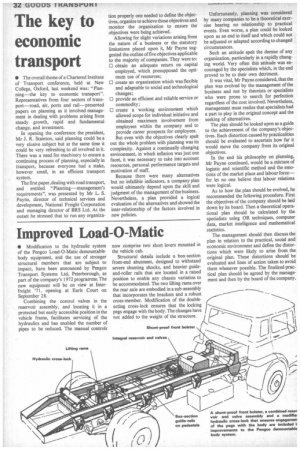The key to economic transport
Page 34

If you've noticed an error in this article please click here to report it so we can fix it.
• The overall theme of a Chartered Institute of Transport conference, held at New College, Oxford, last weekend was: "Planning—the key to economic transport". Representatives from four sectors of transport—road, air, ports and rail—presented papers on planning as it involved management in dealing with problems arising from steady growth, rapid and fundamental change, and investment.
In opening the conference the president, Mr J. R. Stainton, said planning could be a very elusive subject but at the same time it could be very refreshing to all involved in it. There was a need for machinery to ensure a continuing process of planning, especially in transport, because everyone had a stake. however small, in an efficient transport system.
The first paper, dealing with road transport, and entitled "Planning management's requirements", was presented by Mr L. S. Payne, director of technical services and development, National Freight Corporation and managing director of BRS Ltd. At the outset he stressed that to run any organiza tion property one needed to define the objectives, organize to achieve those objectives and monitor the organization to ensure the objectives were being achieved.
Allowing for slight variations arising from the nature of a business or the statutory limitations placed upon it, Mr Payne suggested the outline of five objectives applicable to the majority of companies. They were to: O obtain an adequate return on capital employed, which presupposed the optimum use of resources; O create an organization which was flexible and adaptable to social and technological changes; O provide an efficient and reliable service or commodity; O create a working environment which allowed scope for individual initiative and obtained maximum involvement from employees within the company and to provide career prospects for employees.
But even with the objectives clearly spelt out the whole problem with planning was its complexity. Against a continually changing environment, in which inflation was just one facet, it was necessary to take into account resources, personal performance targets and motivation of staff.
Because there were many alternatives but no infallible indicators, a company plan would ultimately depend upon the skill and judgment of the management of the business. Nevertheless, a plan provided a logical evaluation of the alternatives and showed the inter-relationship of the factors involved in new policies. Unfortunately, planning was considered by many companies to be a theoretical exercise bearing no relationship to practical events. Even worse, a plan could be looked upon as an end in itself and which could not be adjusted or adapted according to changed circumstances.
Such an attitude spelt the demise of any organization, particularly in a rapidly changing world. Very often this attitude was encouraged by the specialists which, in the end proved to be to their own detriment.
It was vital, Mr Payne considered, that the plan was evolved by the management of the business and not by theorists or specialists who were prone to search for perfection regardless of the cost involved. Nevertheless, management must realize that specialists had a part to play in the original concept and the seeking of alternatives.
The plan should be looked upon as a guide to the achievement of the company's objectives. Each distortion caused by practicalities should be evaluated to ascertain how far it would move the company from its original objectives.
In the end his philosophy on planning, Mr Payne continued, would be a mixture of logistic and scientific method and the emotions of the market place and labour force— for let no one believe that labour relations were logical.
As to how the plan should be evolved, he recommended the following procedure. First the objectives of the company should be laid down by its board. Then a theoretical operational plan should be calculated by the specialists using OR techniques, computer data, market intelligence and mathematical statistics.
The management should then discuss the plan in relation to the practical, social and economic environment and define the distortions which were likely to arise from the original plan. These distortions should be evaluated and lines of action taken to avoid them whenever possible. The finalized practical plan should be agreed by the management and then by the board of the company.










































































































